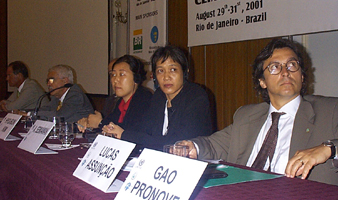 Sustainable Developments
Sustainable Developments |
5th UNCTAD/Earth Council
Policy Forum on Trade and Climate Change (Rio Policy Forum):
The State of the Greenhouse Gas (GHG) Market
29-31 August
2001, Rio de Janeiro, Brazil
Update for Friday 31 August 2001:
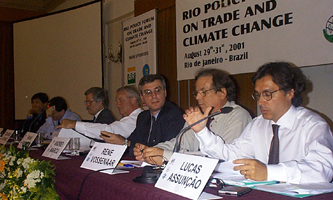 The 5th UNCTAD/Earth Council Policy Forum on
Trade and Climate Change came to a close late Friday afternoon, after
hearing panel discussions throughout the day. Lucas
Assunção, Policy Forum Coordinator, gave a short presentation to sum
up and conclude the meeting. He emphasized that the Kyoto Protocol is
untested and not flawed and noted that a signal from the Forum to COP-7
is that the Forum attempted to start this testing. Delegates then
proceeded to the final reception hosted by UNCTAD, Earth council and
IETA. Right photo: The dias during the concluding panel
The 5th UNCTAD/Earth Council Policy Forum on
Trade and Climate Change came to a close late Friday afternoon, after
hearing panel discussions throughout the day. Lucas
Assunção, Policy Forum Coordinator, gave a short presentation to sum
up and conclude the meeting. He emphasized that the Kyoto Protocol is
untested and not flawed and noted that a signal from the Forum to COP-7
is that the Forum attempted to start this testing. Delegates then
proceeded to the final reception hosted by UNCTAD, Earth council and
IETA. Right photo: The dias during the concluding panel
|
| Panel Discussions: |
| The State of the GHG Market: Views of GHG Offsets Exporting Countries |
| Views from the Public Sector: |
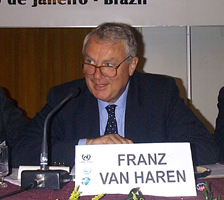 This session, moderated by Frans van Haren (right), Earth Council Institute, addressed what is happening and being done in export countries regarding GHG offsets, how developing countries are preparing for the emerging GHG market, and what can be done to enhance the capacity of export countries. Van Haren said those expected to provide the environmental services are in the drivers seat and will play a central role. |
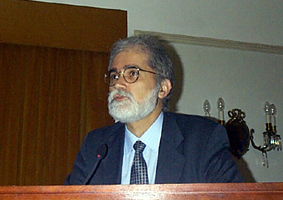 Jose
Miguez (right), Brazilian Ministry of Science and Technology, talked on
developments in Brazil regarding GHG offsets. He noted Brazil's signing
of the UNFCCC and Kyoto Protocol, the coordinating function of the
Interministerial Commission on Sustainable Development, and country
agencies involved in Brazil's efforts. Jose
Miguez (right), Brazilian Ministry of Science and Technology, talked on
developments in Brazil regarding GHG offsets. He noted Brazil's signing
of the UNFCCC and Kyoto Protocol, the coordinating function of the
Interministerial Commission on Sustainable Development, and country
agencies involved in Brazil's efforts.
|
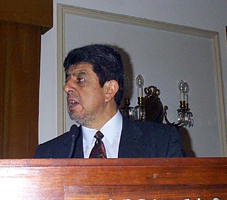 Eduardo
Sanhueza, National Strategy Studies Programme for the implementation of
the CDM, noted Chile's ratification of the UNFCCC in 1994 but said a
real understanding of the climate change problem and solutions began
later. He noted Chile's active participation in and commitment to the
climate process and the ensuing CDM opportunity. Sanhueza noted Chile's
views on the CDM, including that sinks is a strategic issue for Chile. Eduardo
Sanhueza, National Strategy Studies Programme for the implementation of
the CDM, noted Chile's ratification of the UNFCCC in 1994 but said a
real understanding of the climate change problem and solutions began
later. He noted Chile's active participation in and commitment to the
climate process and the ensuing CDM opportunity. Sanhueza noted Chile's
views on the CDM, including that sinks is a strategic issue for Chile.
|
| Jan Pretel, Czech Hydrometeorological Institute, shared his views on the introduction of a domestic GHG market in the Czech Republic. Implementing an emissions trading scheme in an Economy In Transition (EIT) is different from an emissions trading scheme in developed economies. |
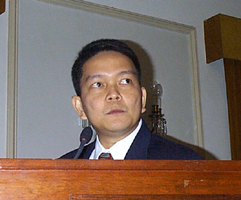 Jose Villarin (left), Climate Change Information System, Philippines, concluded that much desk work has been done to prepare his country for the emerging GHG market. One main goals of the Philippines is to establish a framework for CDM projects, starting with identifying types of projects, set up the operational and legal framework, institutionalize access to information, and finally executing projects. |
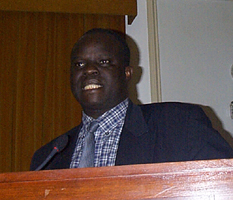 Richard Muyungi (left), Vice Presidents office, Tanzania, spoke on potential for investing in LDCs. He highlighted the geographical location of LDCs and noted their preoccupation with immediate problems such as poverty eradication, employment generation, and HIV/AIDS. Muyungi said lack of infrastructure/capacity is a key feature and stressed the private sector hardly knows about GHG trading. |
| Jean Acquatella, CEPAL, examined how the size of the future GHG market would vary with and without the participation of the United States. In general, the projected size of the market is very large, but when a large potential buyer such as the United States pulls out, an imbalanced supply and demand will result. |
| Views from the Private Sector: |
|
|
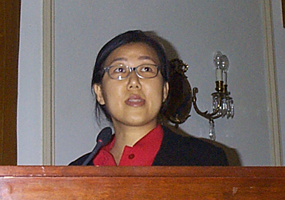 Ms. Hyo-Sun Kim, Korea Gas Corporation, stated that 80 percent of the GHG are generated by the energy sector, even as natural gas is expected to increase its share of primary energy consumption to 15 percent by 2020. Korea expects to become an exporter of offsets. |
|
Fernando Almeida, Brazilian Business Council on Sustainable Development, spoke on how the Kyoto Protocol can contribute to the goal of sustainable development in his country. There are many disenfranchised people in Brazil, and CDM projects must benefit them in addition to generating offsets. |
| Mauricio Reis, Companha Vale do Rio Doce, is one of Brazil's largest companies, and is one of the founders of the Brazilian Business Council on Sustainable Development. On carbon sinks projects, particularly in the sensitive Amazon region, projects must contribute to the comprehensive set of environmental, social and economic goals. It must benefit as many people as possible. Just selling some offsets is not in the interest of the Brazilian people. |
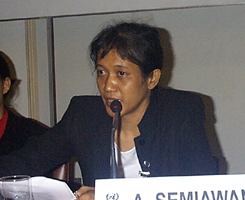 A.
Semiawan, PLN-Indonesia, highlighted the characteristics of state-owned
electricity company PLN, a buyer and seller of electricity. She detailed
PLN's buying arrangements with independent power producers (IPP). She
outlined their negotiations with a geothermal power plant, noting how CDM
implementation was part of the contract settlement and how CO2 credits
could be shared under the arrangement. Semiawan highlighted benefits of
the CDM, which can help PLN and IPP. These include financial benefits,
enhancing capacity building and technology transfer, and promotion of
renewable energy in Indonesia. A.
Semiawan, PLN-Indonesia, highlighted the characteristics of state-owned
electricity company PLN, a buyer and seller of electricity. She detailed
PLN's buying arrangements with independent power producers (IPP). She
outlined their negotiations with a geothermal power plant, noting how CDM
implementation was part of the contract settlement and how CO2 credits
could be shared under the arrangement. Semiawan highlighted benefits of
the CDM, which can help PLN and IPP. These include financial benefits,
enhancing capacity building and technology transfer, and promotion of
renewable energy in Indonesia.
|
| Eduardo P. Carvalho, UNICA, spoke on sugar cane energy and green house gas reduction. He highlighted Brazil's production and consumption of fuel alcohol. Carvalho said sugar cane is an energy engine and is perhaps one of the most efficient energies in the world. He underscored the potential of sugar and alcohol production to reduce CO2 emissions and said the CDM will enhance this potential. |
| Pablo Mandeville, UNDP, outlined numeric elements of a study on implications of the Bonn Agreement on the carbon market and the CDM in Latin America. The analysis projected a decline of 40 – 55 percent in demand if the United States would indeed withdraw from the Kyoto Protocol. |
| Market Makers: |
 On Friday afternoon, a market makers panel, moderated by Sergio Besserman (right), National Institute of Statistics and Geography (IBGE), looked at what funds and other market actors are doing to develop the GHG market/s. The IBGE has been charged with establishing an inventory of GHG in Brazil, and will play a role in the dissemination of information about GHG emissions. Only recently has the organization become involved in collecting and disseminating environmental data, and this has presented its own set of challenges. |
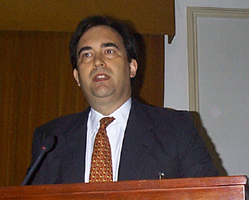 Francisco Hoyos, Fondelec, explained that his company is a private equity investment firm focused on the use of clean energy, energy efficiency, and GHG emission reductions. |
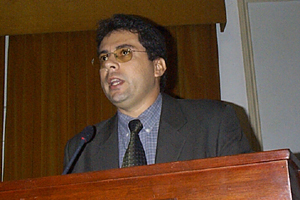 Teobaldo Leal, Banco do Nordeste, signaled that the market in Northeastern Brazil will open up for eco-investments in the near future, a densely populated and economically diversified region of Brazil. |
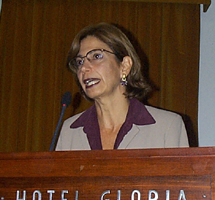 Isaura Frondizi, National Development Bank (NDB), explained her bank's role in the environmental field in Brazil. The bank assists the Inter-ministerial Committee on Climate Change, the main vehicle for climate change policies, on financial aspects. |
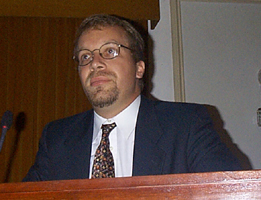 Marc
Stuart, EcoSecurities, discussed the supply and demand fundamentals in the
emerging GHG market. He argued that while some estimates exist, it may not
be possible to estimate the full potential of the market until the
Protocol is ratified and operational. Marc
Stuart, EcoSecurities, discussed the supply and demand fundamentals in the
emerging GHG market. He argued that while some estimates exist, it may not
be possible to estimate the full potential of the market until the
Protocol is ratified and operational.
|
 Neil
Cohn, Natsource, observed that the current market for GHG has been
voluntary so far and has not been governed by established rules and
regulations. The result has been an illiquid market with relatively high
transaction costs, however, over 60 actual trades have been recorded,
representing 55 million dollar worth of transactions, with strongest
demand for 2008 – 2012 vintages. Neil
Cohn, Natsource, observed that the current market for GHG has been
voluntary so far and has not been governed by established rules and
regulations. The result has been an illiquid market with relatively high
transaction costs, however, over 60 actual trades have been recorded,
representing 55 million dollar worth of transactions, with strongest
demand for 2008 – 2012 vintages.
|
 John
O'Brien, Enviros, explained some of the intricacies of the United
Kingdom's GHG markets, including the Emissions Trading Scheme (ETS) and
the Climate Change Levy (CCL). Initially, companies in several
energy-intensive industrial sectors were taxed on their energy use, but
could get up to 80 percent CCL discount if they would implement energy
saving practices. John
O'Brien, Enviros, explained some of the intricacies of the United
Kingdom's GHG markets, including the Emissions Trading Scheme (ETS) and
the Climate Change Levy (CCL). Initially, companies in several
energy-intensive industrial sectors were taxed on their energy use, but
could get up to 80 percent CCL discount if they would implement energy
saving practices.
|
| Concluding Panel: |
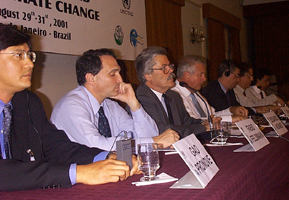
The concluding panel, moderated by Rene Vossenaar, UNCTAD, addressed how buyers and sellers can advance the emerging global GHG market and what can be done to enhance the capacity of developing countries to participate in this market.
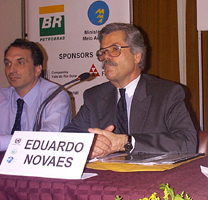 Eduardo
Novaes (far right), Ministry of the Environment,
Brazil, highlighted relevant activities of the Ministry including its
mandate and role in promoting climate projects. He outlined its project
management activities and noted the establishment and work of an
integrated studies center of climate change. Novaes highlighted
initiatives directed at preparation for the emerging market.
Eduardo
Novaes (far right), Ministry of the Environment,
Brazil, highlighted relevant activities of the Ministry including its
mandate and role in promoting climate projects. He outlined its project
management activities and noted the establishment and work of an
integrated studies center of climate change. Novaes highlighted
initiatives directed at preparation for the emerging market. Mr. Fabio Feldmann (right), Brazilian Forum on Climate Change, highlighted the Forum's formation, composition and structure and noted its main objective is to act as an interface between government and civil society. He identified the government agencies that support the Forum, noted partnerships with diverse sectors and highlighted strategies including following up on negotiations, awareness and capacity building, technical meetings, debates and publications.
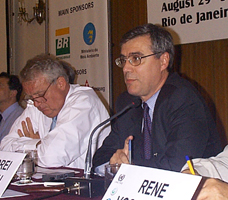 Andrei
Marcu (far right), IETA, underscored the challenge of supporting the Kyoto deal and
addressing the details. He noted that business is generally supportive
because the deal provided certainty for a carbon-constrained market.
However eliminating uncertainties created new uncertainties. The US
withdrawal raised the possibility of 2 trading systems applying and there
would be a need to promote uniformity.
Andrei
Marcu (far right), IETA, underscored the challenge of supporting the Kyoto deal and
addressing the details. He noted that business is generally supportive
because the deal provided certainty for a carbon-constrained market.
However eliminating uncertainties created new uncertainties. The US
withdrawal raised the possibility of 2 trading systems applying and there
would be a need to promote uniformity.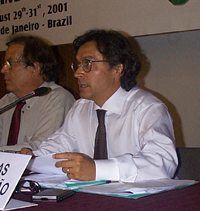 Lucas
Assunção, Policy Forum Coordinator, gave a short presentation to sum up
and conclude the meeting. He emphasized that the Kyoto Protocol is
untested and not flawed and noted that a signal from the Forum to COP-7 is
that the Forum attempted to start this testing. Assunção identified the
current status of the GHG market environment, including polices and
measures being adopted and demand for credits created. UNCTAD/Earth
Council can contribute through the Policy Forum and its derivatives,
down-to-earth research, an upcoming training programme and capacity
building. Assunção then thanked sponsors, participants and contributors
and brought the meeting to a close.
Lucas
Assunção, Policy Forum Coordinator, gave a short presentation to sum up
and conclude the meeting. He emphasized that the Kyoto Protocol is
untested and not flawed and noted that a signal from the Forum to COP-7 is
that the Forum attempted to start this testing. Assunção identified the
current status of the GHG market environment, including polices and
measures being adopted and demand for credits created. UNCTAD/Earth
Council can contribute through the Policy Forum and its derivatives,
down-to-earth research, an upcoming training programme and capacity
building. Assunção then thanked sponsors, participants and contributors
and brought the meeting to a close.|
|
|
 |
|
 |
|
 Earth
Negotiations Bulletin's coverage of UNFCCC COP6-bis Earth
Negotiations Bulletin's coverage of UNFCCC COP6-bis |
|
|
* To view PDF files, you will need the free Adobe Acrobat Reader. . |

